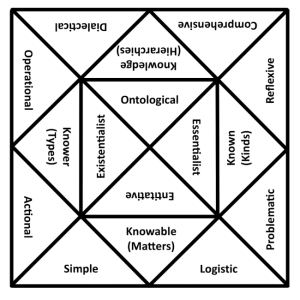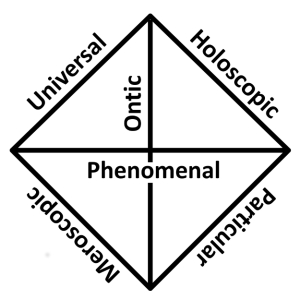 Previously on this blog:
Previously on this blog:
Each method can be associated with a discursive process: operational with debate, dialectical with dialogue, logistic with proof, and problematic with inquiry. Each method is also associated with a mode of thought which in turn has two moments and one dependency or assumption: the operational method is debate by discrimination and postulation dependent on chosen theses, the dialectical method is dialogue by assimilation and exemplification dependent on changeless models, the logistic method is proof by construction and decomposition dependent on indivisible constituents, and the problematic method is inquiry by resolution and question dependent on discoverable causes.
For this diagram, the four dependencies or assumptions are in the center, and the associated methods are adjacent to them. Filling out the outer edge are the four pairs of moments. Listed, these facets are:
- Methods (associated discursive process): Operational (Debate), Dialectical (Dialogue), Logistic (Proof), Problematic (Inquiry)
- Assumptions: Chosen Theses, Changeless Models, Indivisible Constituents, Discoverable Causes
- Modes of Thought: discrimination and postulation, assimilation and exemplification, construction and decomposition, resolution and question
 The second diagram comes from a chart in McKeon’s “Philosophic Semantics and Philosophic Inquiry”. Here, the four methods are in the upper left corner (Universal) and lower right corner (Particular), and four principles are in the lower left corner (Meroscopic) and upper right corner (Holoscopic). Four interpretations are in the center (the vertical pair is Ontic, and the horizontal pair is Phenomenal), and four selections are adjacent to them. Listed, these facets are:
The second diagram comes from a chart in McKeon’s “Philosophic Semantics and Philosophic Inquiry”. Here, the four methods are in the upper left corner (Universal) and lower right corner (Particular), and four principles are in the lower left corner (Meroscopic) and upper right corner (Holoscopic). Four interpretations are in the center (the vertical pair is Ontic, and the horizontal pair is Phenomenal), and four selections are adjacent to them. Listed, these facets are:
- Methods: Operational, Dialectical, Logistic, Problematic
- Principles: Simple, Actional, Comprehensive, Reflexive
- Interpretations: Existentialist, Entitative, Ontological, Essentialist
- Selections: Knower (Types), Knowable (Matters), Knowledge (Hierarchies), Known (Kinds)
Note that the Archic Matrix of Watson and Dilworth is essentially derived from this, and even has many of the same terms. However and obviously, the sixteen-fold arrangements of the two diagrams are different.
Further Reading:
[*5.184, *5.185, *6.20, *11.102, *11.106]
<>


















